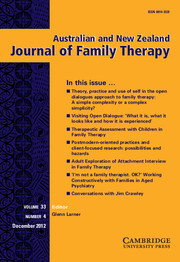Article contents
A Family Therapist's Look Into Interpersonal Neurobiology and the Adolescent Brain: An Interview With Dr Daniel Siegel
Published online by Cambridge University Press: 02 March 2012
Abstract
Advances in brain research are increasingly having an impact on clinical interventions in all fields of psychotherapy. For adolescent family therapists it is important not only to understand the developing adolescent brain, but also how brain research can influence interventions aimed at interrupting problematic familial interactions. Interpersonal neurobiology and the ideas of Dr Daniel Siegel synthesise the interpersonal with the scientific, offering practical clinical methods of incorporating the research into everyday practice. This article incorporates a verbatim interview with Dr Siegel about the adolescent brain, interpersonal neurobiology and attachment with an outline of key concepts from interpersonal neurobiology including the hand model of the brain, nine functions of the prefrontal cortex, the triangle of wellbeing and eight domains of integration. Clinical applications are suggested using a common presenting problem of escalating conflict between teenagers and their parents.
- Type
- Articles
- Information
- Australian and New Zealand Journal of Family Therapy , Volume 31 , Issue 3 , 01 September 2010 , pp. 285 - 299
- Copyright
- Copyright © Cambridge University Press 2010
- 4
- Cited by




